A number of LinkedIn readers wanted more detail about my conversion of my 1975 Triumph Spitfire to a fully electric vehicle, so I thought I’d put together a LinkedIn version of an article I wrote for my local Toronto Triumph Club magazine, “Ragtop”.
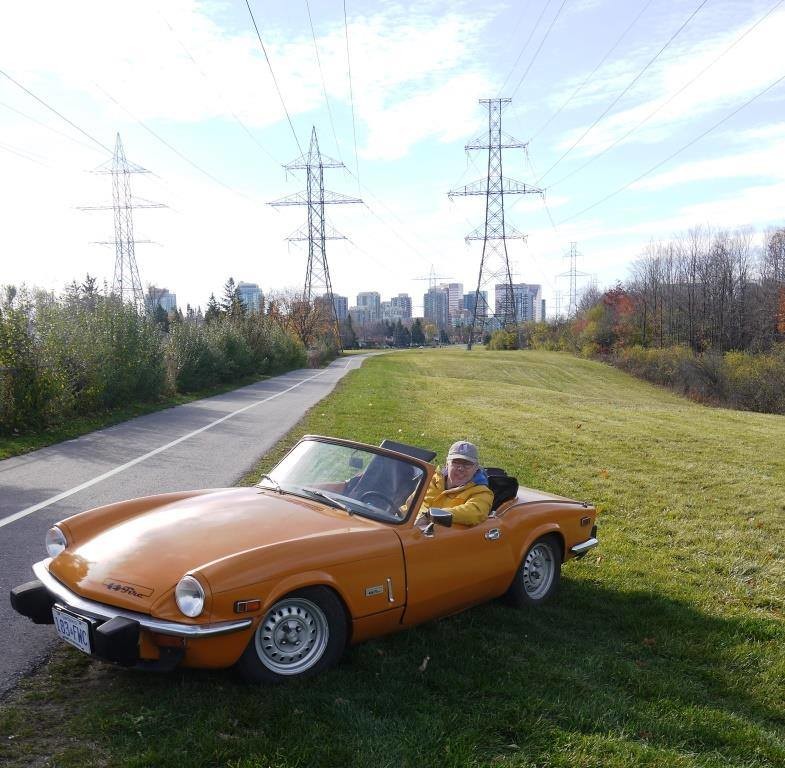
(E-Fire, with its fuel pipeline in the background)
I bought my 1975 Spitfire 1500 in 1988. I was young, foolish, and wanted a car which would give me an opportunity to learn some skills from my father, a retired diesel mechanic and jack of all trades. When I saw those fenders come up with the hood, and the engine sitting there on the frame, I was sold! Not having to work in a cramped engine bay was a major selling point- if only I’d known just how much work that engine would take! I eventually replaced the Leyland engine and transmission with a 2.2L Toyota Celica 20R with a W50 five speed. It never really fit, giving the car an unattractive grin- but it certainly made the car a lot more fun!
The last validation sticker I had on the license plate was from 1996- not coincidentally, the year I started my dreaded 122 km/day commute and moved in with the girl who didn’t like the car…but it wasn’t going to the junkyard quite yet, despite my wife’s pestering. I thought I’d get back to it someday, and then when our son came along, it naturally turned into a future project that the two of us would do together. But what would power it?
By the time my son Jacob was 11 and mature enough to be helpful, I started looking seriously into electric drivetrain technology. With a Prius and a Prius C as our two daily drivers, I was already fascinated by how seamlessly and reliably all the hybrid stuff in those cars “just works”- the driver is unaware of it, and yet it dramatically improves both torque and fuel economy, as well as greatly extending the life of the braking system. Regrettably though, years of storage in a leaky garage, and three years under a tarp during a major renovation of the house, had turned the Spitfire into a Fred Flintstone car.
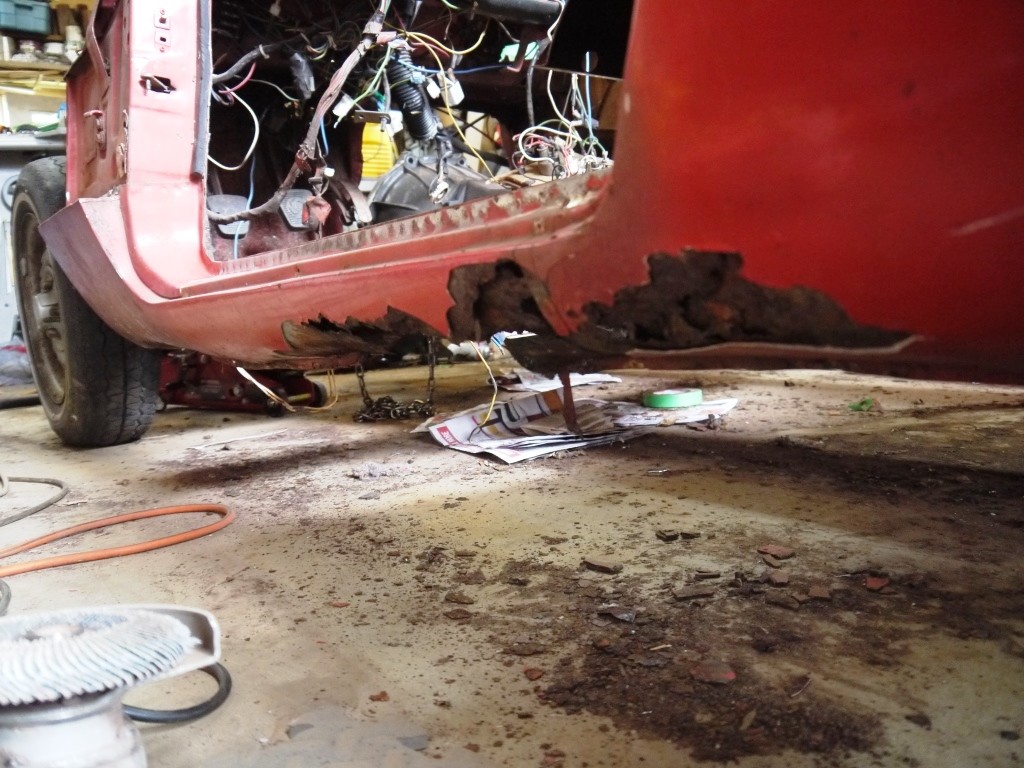
(before any conversion work was possible, a lot of rust repair was required!)
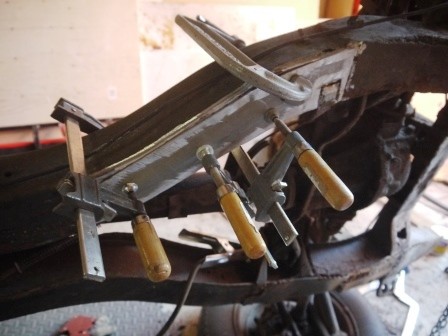
(parts of the frame/chassis were rusty enough to need reinforcement)
I stumbled across www.diyelectriccar.com and found a whole community of people passionate about converting cars to electric drive. Many Spitfires, TR6s and other classics had already been converted. I also came across Canadian Electric Vehicles, a company on Vancouver Island who sells conversion parts as well as building fully electric low-speed utility vehicles, along with a helping hand to get the projects going. I started putting a parts list together.
I also started doing a little research into the history of electric cars. Apparently, electric cars out-numbered engine-driven cars until about 1912, which not coincidentally is the year after the electric starter was invented. Until about 1900, electrics were also the fastest vehicles on the road.
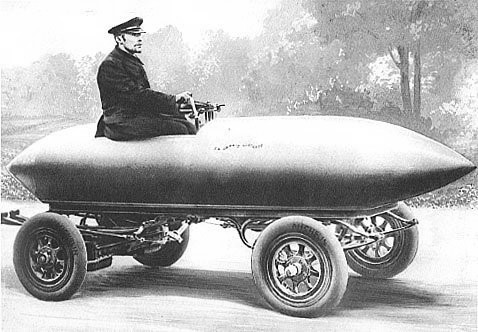
(Belgian Emile Jenatzy with his electric speed record winner, “La Jamaise Contente” – 66 miles per hour in 1890)
Compared with the horse- 175,000 of them in New York City alone at the turn of the last century, emitting some 1500 tonnes per day of “effluent”, along with the flies and rats they attracted- cars were an environmental godsend. But once the electric starter was invented, ladies and gentlemen no longer needed a chauffeur- and the enormous energy density of gasoline won the day. Every general store became a gas station, and the electric car faded into history.
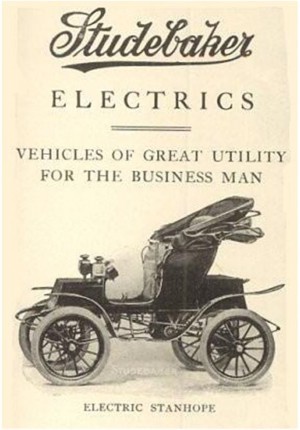
(The Studebaker Electric)
So, what changed between now and then? Three things: batteries, air pollution, and global warming.
The nickel-metal hydride battery was a good start, but when the lithium-ion battery became popular in portable electronics and power tools in the 1990s, vehicle applications were a natural follow-on. The batteries are extremely efficient, giving back about 90% of the energy they are fed from the power mains. Their practical energy density is almost ten times as great per unit weight as the lead-acid battery- and they can last through thousands of charge/discharge cycles if managed properly.
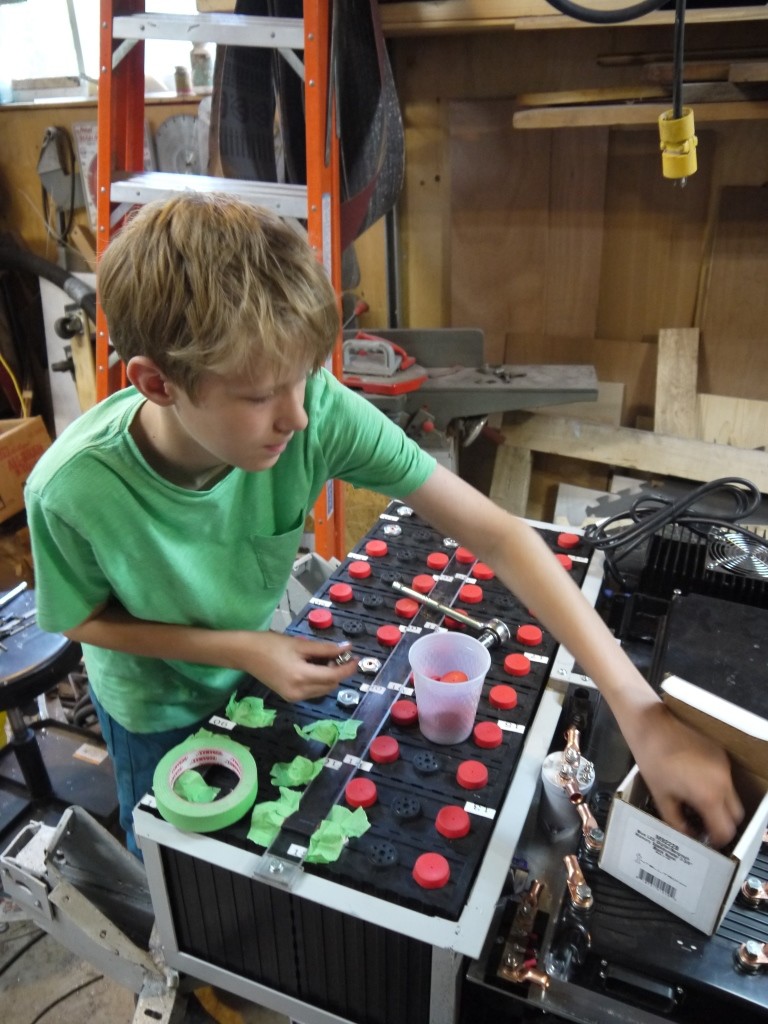
(Jacob wiring the front battery pack- 22 LiFePO4 180Ah batteries)
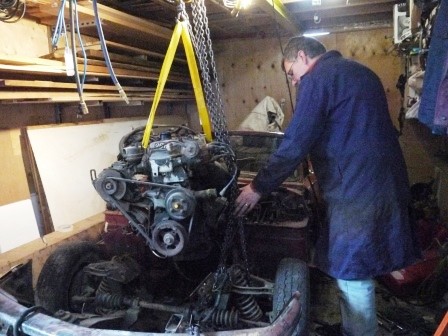
(pulling the Toyota 20R engine out of the Spitfire…a tad too big!)
The problem with the gasoline engine car wasn’t the car itself. Rather, it was the same problem encountered by our previous transportation technology, the horse. Horses are great in a rural setting- you can grow their food, and their manure fertilizes the land. But in cities, mass use made the horse an environmental disaster. So too with the internal combustion engine: a few of Rudolph Diesel’s tractors running on peanut oil were one thing, and tens of millions of cars with one person each in them were quite another. Emission controls got rid of most, but not all, of the toxic tailpipe emissions (while also adding complexity and cost and eating horsepower)- but when we discovered that CO2 concentrations in the atmosphere had nearly doubled as a result of our fossil fuel consumption with no end in sight, the world’s climate scientists started sounding the alarm bells.
According to the people who have the training to have an opinion worth considering as truly informed on this topic, there is a risk of severe consequences to the earth’s climate if we don’t do something about fossil fuel emissions to the atmosphere. Nobody knows the exact extent, but the overwhelming majority suggest that the outcome isn’t good. And with billions in India, China, Brazil , Indonesia and elsewhere aspiring to the same mobility and freedom we in the developed world have enjoyed for the past sixty or seventy years, getting a handle on our transportation uses of fossil fuels has to be a high priority.
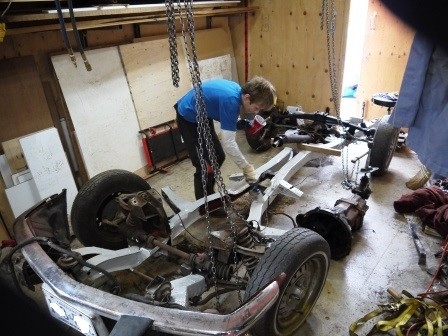
(body off frame restoration complete- Jacob applying primer)
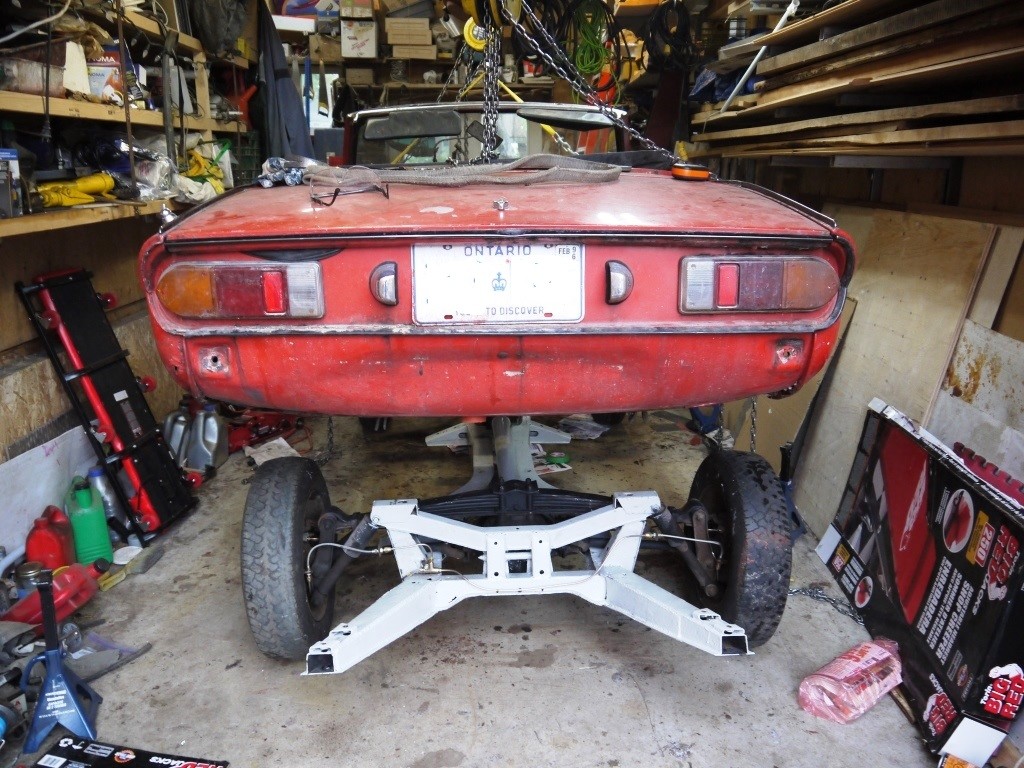
(the rotten body going back onto the restored frame)
The gasoline engine is a marvellous machine. It used a fuel that was originally a worthless byproduct of kerosene manufacture- a fuel which could be mined rather than needing to be grown. The fuel has an energy density of some 2,400 Wh/kg at a gasoline engine’s average 25% thermodynamic efficiency. That’s still ten times better than the best battery technology available today, in the form of a liquid you can just pour into a tank. But regrettably, that still means that from the crude oil well to the engine shaft, only about 20.5% of the energy taken from the ground ends up as useful work. The rest is waste heat, dumped out via the radiator to later cook you through every hole in your Spitfire’s firewall!
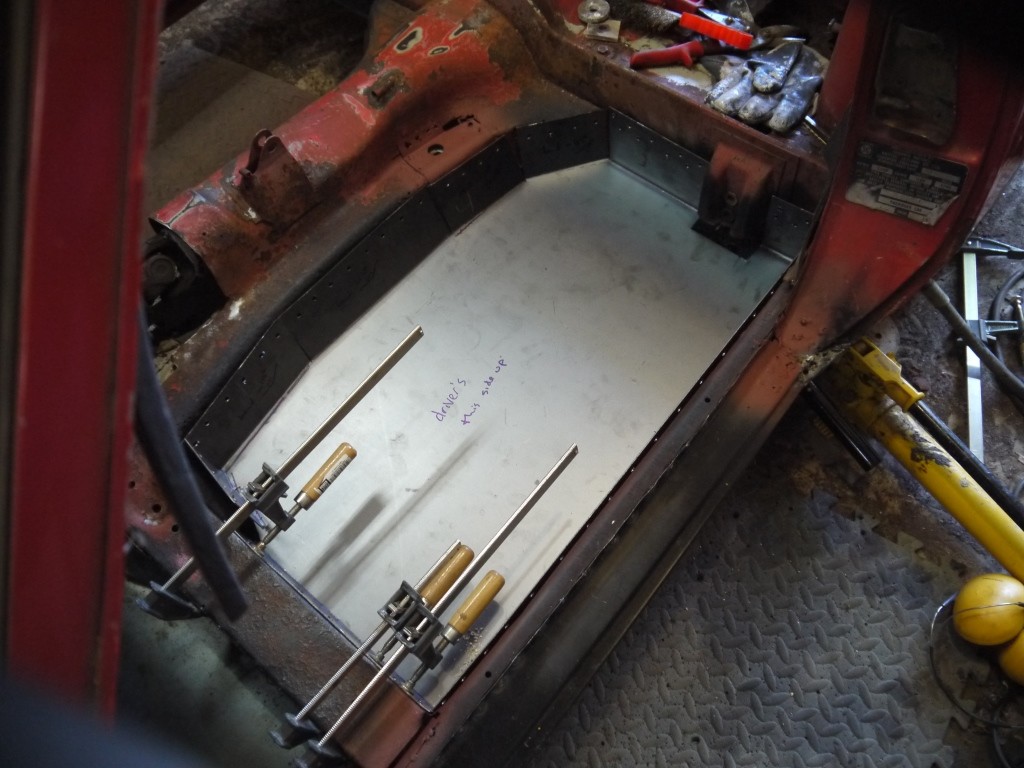
(fabricating new floorpans, so the car would no longer suit Fred Flintstone!)
In comparison, an electric vehicle drivetrain consists of only a few parts: a charger, the batteries, an electronic motor controller and an electric motor. With 6% losses from the electrical grid figured in, and all losses considered, that’s about 75% efficiency from power plant to motor shaft without trying too hard. Even when the source of electricity is a fossil fuel burned in a modern combined-cycle power plant, there is a net energy efficiency benefit to using an electric drivetrain. When you consider that Ontario’s electrical grid is 0% coal and only 9.2% natural gas-fueled on average, the balance coming from nuclear and renewables such as hydro power, the electric vehicle’s efficiency in greenhouse gas emissions terms is rivalled only by electrified public mass transit.
Another benefit of the electric drivetrain is the opportunity for regenerative braking, which can save 10-15% of the energy fed to a car which is normally wasted as heat by the braking system. It does this with zero wear to the braking system, so less frequent brake replacement is another benefit.
So after much study, we settled on an AC electric drivetrain for the Spitfire:
1) a High Performance Electric Vehicle Systems (HPEVS) AC-50 3-phase vehicle induction motor, capable of about 120 ft-lbs of torque from 0-3500 rpm and a peak power of about 77 horsepower
2) a Curtis 1238 AC inverter motor controller capable of 650 A DC forward current and 200 A of regenerative braking
3) a series string of 32 Sinopoly 3.2 V 180 amp-hour lithium iron phosphate batteries, capable of storing about 18.5 kWh of electricity at a nominal 105 volts DC. The batteries should last about 3,000 charge-discharge cycles if kept below 70% depth of discharge and not over-charged
4) an ElCon PFC 2500 watt battery charger and
5) a MiniBMS battery management system, which uses a small alarm board on each battery to detect low and high voltage. A high voltage on any cell stops the charger, and a low voltage sounds an alarm to alert the driver
A few additional parts were required too:
- a master contactor, to turn main power on and off to the controller
- an emergency disconnect which can be operated by a pull cable from the dashboard
- a 35A isolated DC/DC converter, using the main battery pack to charge a small lawn tractor 12V battery which operates the car’s normal 12V systems for lighting, horn, radio etc.
- a few relays for useful interlocks, including one that prevents you from driving away with the car plugged in for charging
- an inertial switch, which cuts power to the motor when the car is in a collision
- an ammeter with shunt- this is the main gauge used when driving the car
- an intelligent amp-hour meter, which is the vehicle’s “fuel gauge”
- some 2/0 gauge wire, and a 500 A DC rated fuse
- a “pot box”- a potentiometer which is pulled by the throttle cable and feeds throttle commands to the controller
- a windshield defog heater/blower, which runs off the main battery pack. This is a mandatory requirement to pass a safety inspection in Ontario
The conversion parts were costly- about $16,000 CDN all told- but about $8,000 of that was just for the batteries. If we had the project to do over again, a battery pack from a wrecked Chevy Volt or part of a Nissan Leaf pack would have been a much more economical choice. But if you’re thinking about an electric conversion just to save money on fuel, think again- gasoline is still too cheap to make that a viable proposition.
We chose to keep the transmission and the clutch. While clutchless conversions can be done easily enough, they require a switch to defeat regenerative braking while using the transmission’s synchromesh to change gears (easily done on the Curtis controller). A transmissionless conversion, while possible, is generally a bad idea as it requires you to either give up on “off the line” performance or top speed- you can’t have it all without a very high speed motor. With the transmission, you get BOTH- and the only time you use the clutch is to switch gears. From a stop, you merely step on the accelerator and go- in 1st, 2nd or even in 3rd gear, rather like a golf cart. There is no need to “burn” the clutch at every start, so it should last forever.
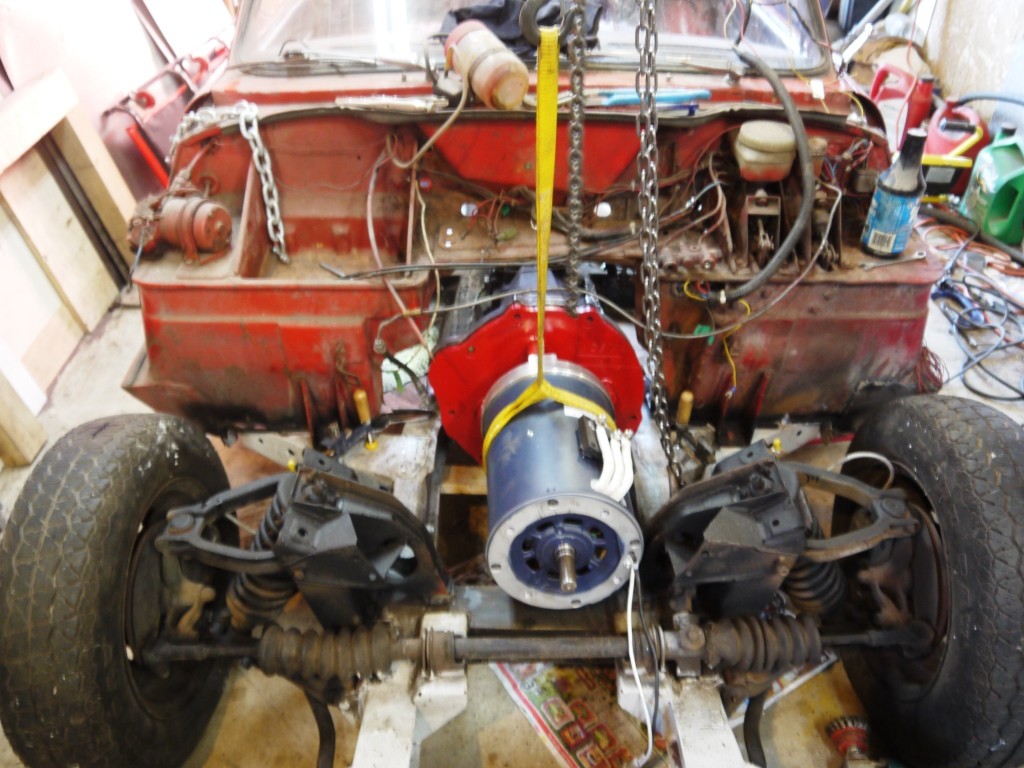
(the AC-50 motor (blue/silver) bolted to the CanEV transmission mounting plate (red))
Canadian Electric Vehicles had a transmission mounting plate and hub to fit my Toyota W50 transmission and the AC-50 motor, ensuring a clean and easy installation without worries about misalignment. Installing the motor took about ½ hour from start to finish. Building these from scratch would take considerable effort, but many converters do this to save money.

(trial fit of the front battery box and the control plate where the inverter and charger will be mounted)
We have 22 batteries mounted in a box ahead of the motor, and another ten in a box located where the gas tank was, with 2/0 cables connecting the two packs. That left me with my entire trunk, and took no room from the passenger compartment. The motor, hub and plate (130lbs) and front batteries (280 lbs) weigh only modestly more than the original 1493 cc engine did with radiator, alternator, manifolds, fluids and exhaust etc., and the rear pack tips in at about 30 pounds heavier than the original tank full of gasoline. Although the battery pack puts the weight somewhat forward of the front wheels when compared to the original car, the overall weight and front-rear weight split is fairly similar. Aside from renewing 40 yr old shocks and springs, no suspension modifications were required.
We started the project in the spring of 2014, removing the engine, exhaust, fuel system etc., and then taking the body bucket off the frame. My 12 yr old son was right there with me, learning skills and, by the end of the project, contributing some really helpful work too. By the fall, we had repaired the structurally important rust damage, installed some Miata seats, had the electric drivetrain installed and the car re-wired, and were ready for a test drive for proof of concept.
My first drive of the electrified car- my first drive of the car since 1996- was, dare I say it- electrifying! All that torque available at zero RPM is intoxicating- especially without the exhaust noise or backwash.
It exceeds the performance of the original Spitfire, still handles like it was on rails, and is an absolute joy to drive! I spent October running the car in little loops around our neighbourhood, shaking the bugs out, before spending the winter on the long and painful process of bodywork and painting. I decided to change the colour from the original pimento to topaz orange to make the car harder to miss on the road, as I intended to drive the car to work and back on nice days. My amateur “orange peel” finish goes perfectly with the colour! This is the first, and hopefully the last, car I will ever paint myself!

(if you’re rich, you can still buy body panels for Spitfires. But I had to do mine the hard way, given that batteries had already broken my budget)
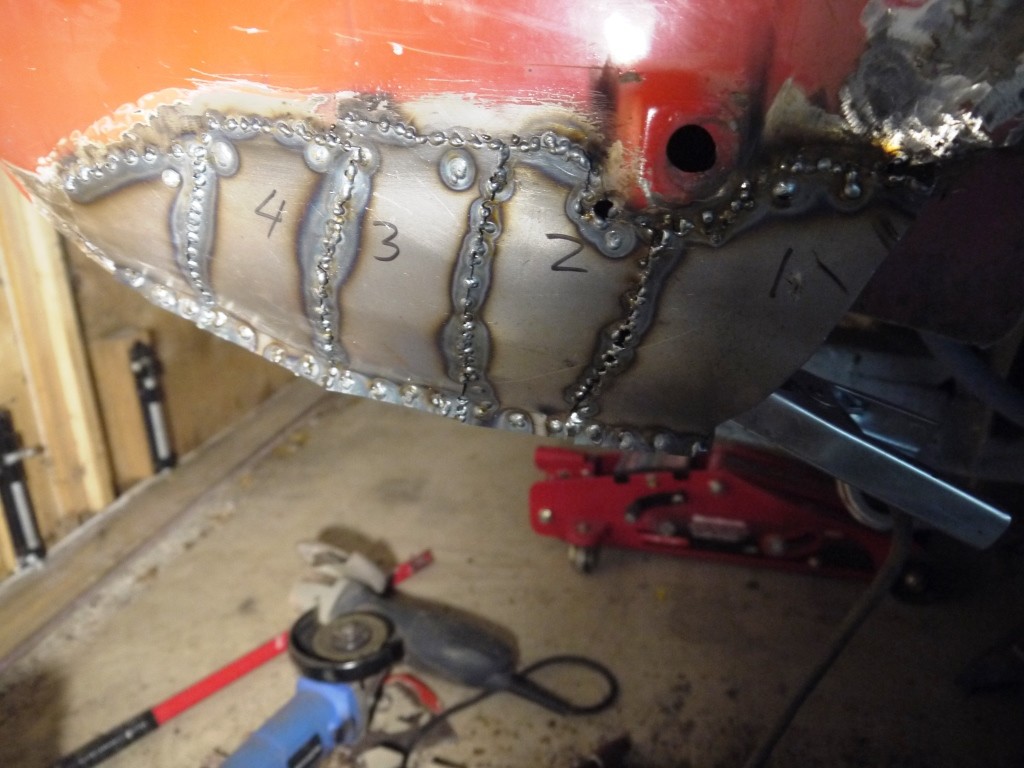
(If I had to do bodywork or welding for a living, I’d starve…but I’m still pretty proud of the results. Only one of my many such repairs is looking shabby after 3 years of daily driving spring through fall- so far, so good!)
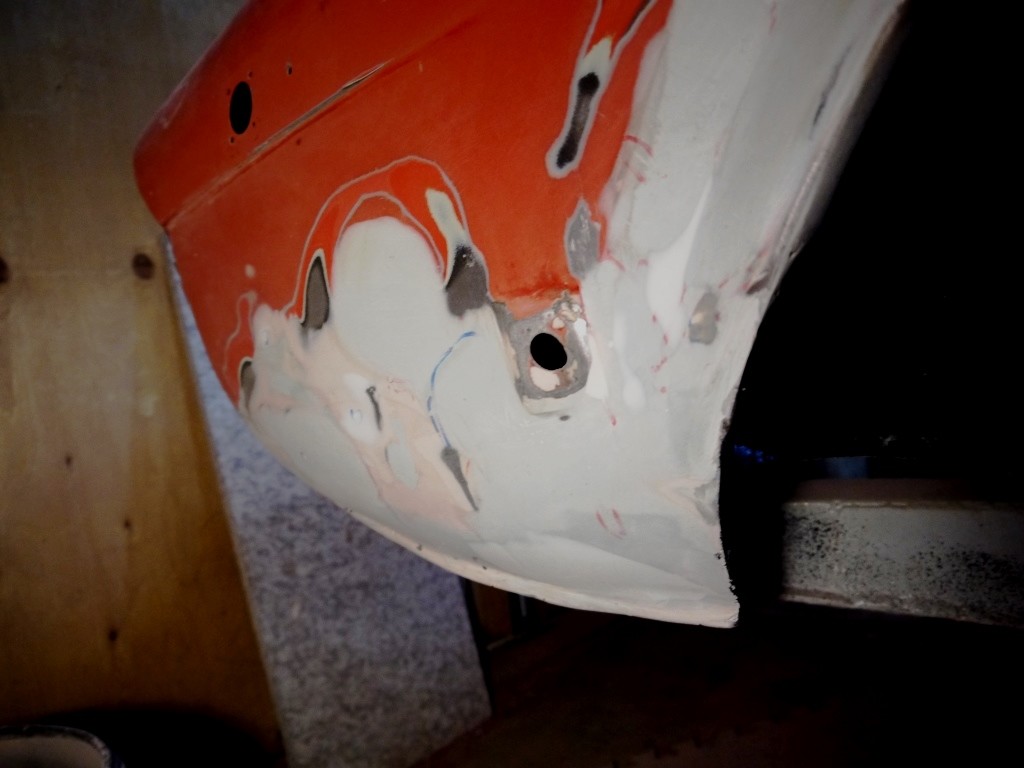
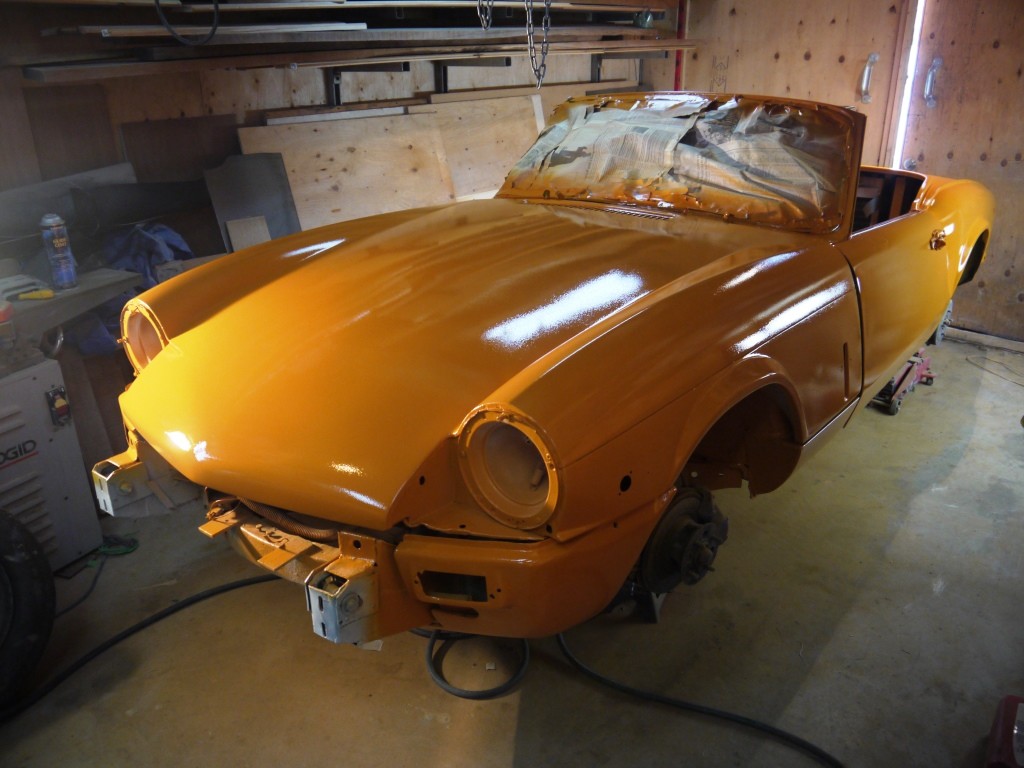
(the body, painted- after much suffering…)
I’ve had both electricians and electrical engineers review my electrical work and have received nothing but compliments. The car passed mechanical safety inspection with only a few minor issues, and was legally on the road in the spring.
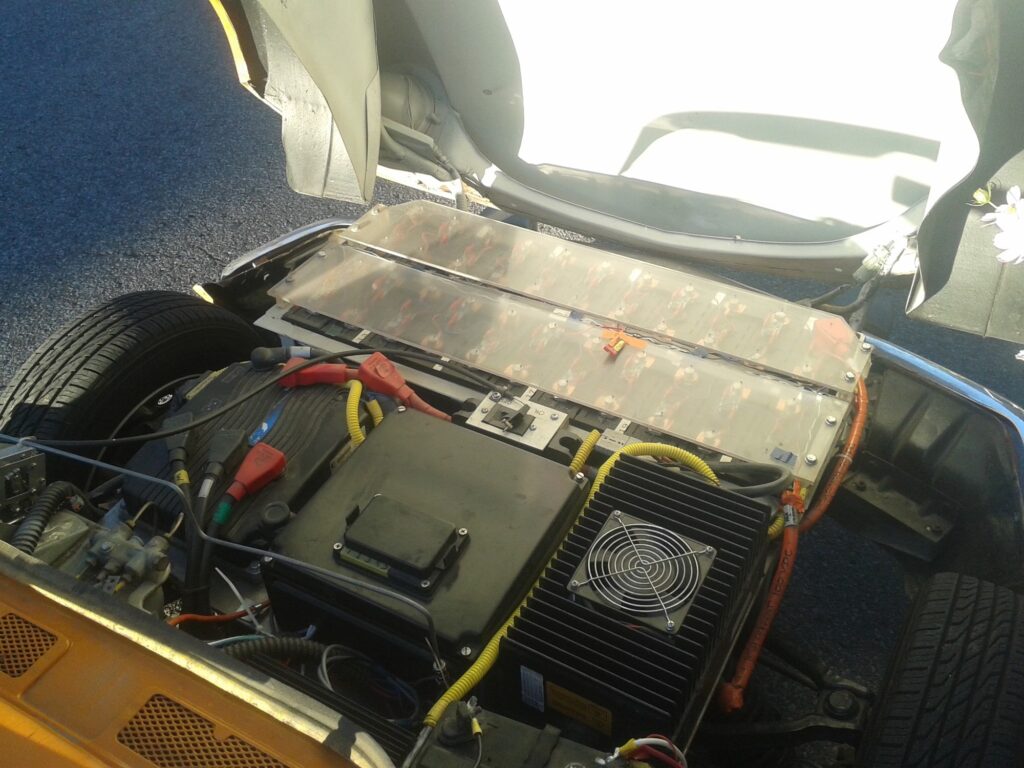
(the E-Fire looks decidedly different under the hood than most Spitfires…leftmost is the Curtis inverter which produces 3 phase AC to drive the motor; middle is my junction box which contains my fuses, interlock relays etc.; right: ElCon PFC2500 charger)
Next to bodywork, finding insurance was the most challenging aspect of the project. Though I had a quote from a major insurer on a full disclosure basis prior to even starting the conversion, they declined to offer coverage when I tried to activate the policy. It seems that our so-called “free market” “competitive” insurance system here in Ontario is not really interested in writing policies for anything out of the ordinary, but some effort negotiating with the insurer’s ombudsman eventually yielded a policy we could both live with- one which permitted me to drive the car as a “real” car rather than a “toy” or “show” car.
In comparison, conversions in BC are insured through the provincial scheme without difficulty. There are many converted cars on Ontario’s roads, and apparently if you find a broker to work with you, coverage is available from a number of insurers (EDIT- not really true! See my subsequent article- finding insurance for an electric conversion in either Ontario or Quebec is next to impossible…but possible!). The irony is, the car is far safer now than it was out of the factory: there is no longer 80 pounds of gasoline separated from the driver and passenger by a 1/8” thick piece of vinyl-covered pressboard, in a tank with a flip-top lid- and the car has a fully redundant braking system which can stop the car even after a total failure of the hydraulic brakes.
Regrettably, there are no tax breaks available for conversion parts or labour, nor are the “green” electric license plates which allow you to drive in the provinces’ HOV lanes available to converted vehicles. But the Ministry of Transportation will permit you to drive the car on the public roads as long as it passes a safety inspection. As a classic there is no requirement to submit to Drive Clean inspections, so no need to re-register the “fuel type”- and there neither an engine computer port nor an exhaust pipe for such an inspection to use, anyway!
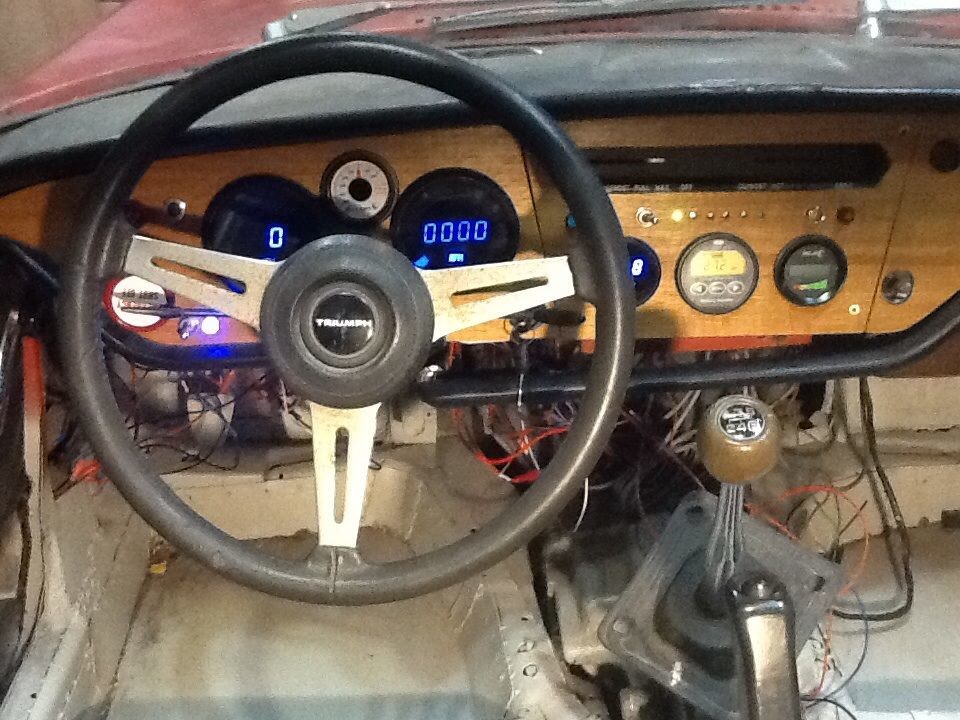
(the dash and re-wiring in progress- a wooden dash not only gives a lovely look, it makes re-building a lot easier. The white gauge nestled between the speedo and tach is the ammeter, which measures battery current both forward (during driving) and reverse (during regenerative braking). The delicious irony of turning a Lucas electric-infested British Leyland car into a reliable fully electric vehicle is not lost on me!)
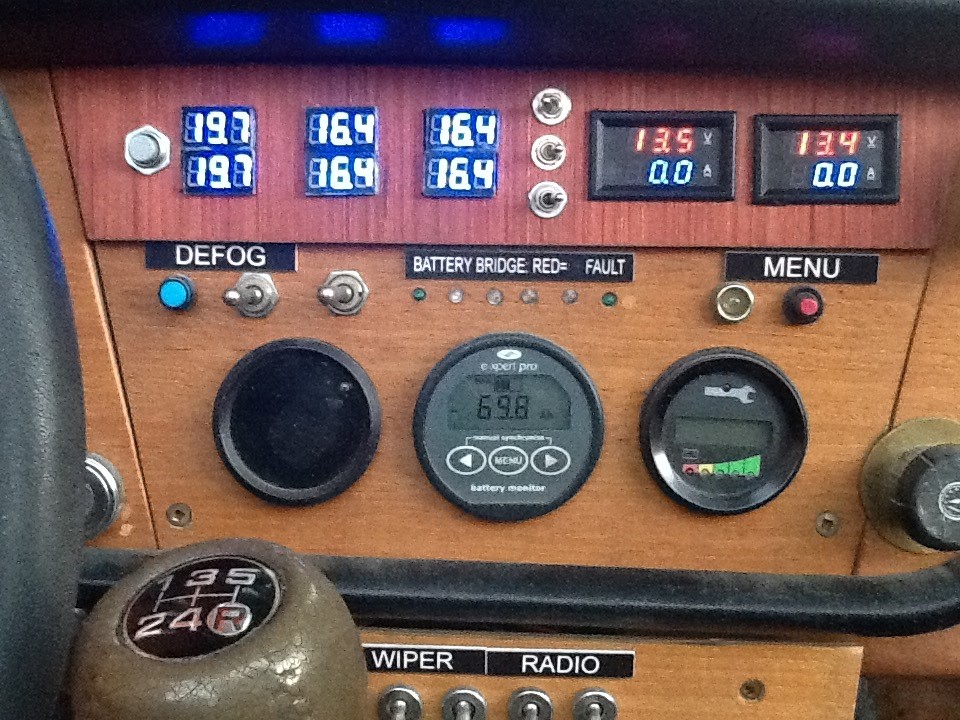
(The E-part of the E-Fire’s dash: a few voltmeters to monitor groups of batteries, DC/DC converter and 12V battery output, the E-Expert Pro Ah gauge (i.e. my fuel gauge) and the ‘Spyglass’ display for the Curtis controller)
So far, the “Triumph E-Fire” as we call it, has been a surprisingly reliable and enjoyable ride. It has a comfortable highway range of about 100 km on a charge. It recharges from my 61 km commute in about 6.5 hours from a normal 120V wall socket- or in half that time from a 240 V electric charging station. We did need to replace the original differential after a failure (hopefully taking the last of the Leyland evil spirits with it!) but I had a spare on hand which seems to be doing fine. So far we have about 14 000 fossil-free miles on the car, saving about 4 900 kg of CO2 emissions to the atmosphere so far. The car emits 3% of the CO2 that it did pre-conversion and is about 79% more energy efficient as well. Surprisingly, it emits about 6% of the CO2 emitted by my Prius C hybrid which gets an impressive 4.5 L/100 km fuel economy.
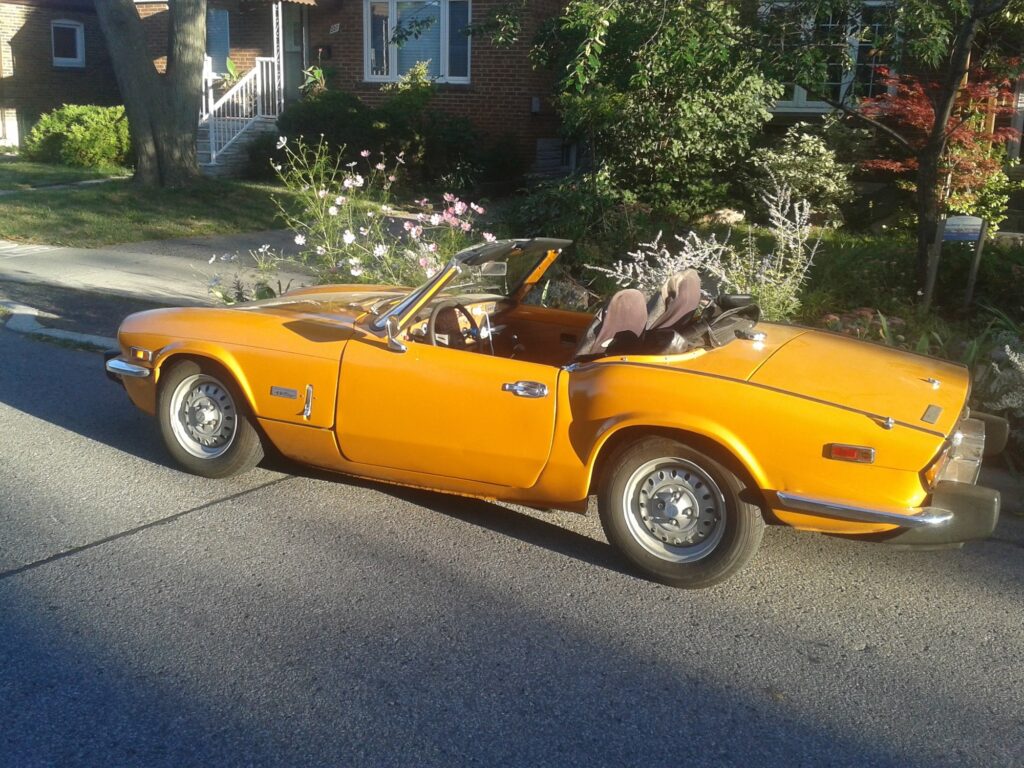
If you have a great car with a terrible engine, or one you can’t get parts for, an electric conversion may be worth considering. It does take some mechanical and electrical skill, but there’s plenty of help available to make the project a success. It’s a way to breathe the spark of life back into a classic car, while making an environmental statement as well.
I invite you to read my other articles, which are generally listed below. In those articles, I attempt to separate the fact from myth and hype in relation to EVs, hydrogen fuelcell electric vehicles, and electric vehicle battery packs.
UPDATE: Sadly, driving home one July evening in 2018, a large Dodge 2500 pickup truck with dual rear wheels changed lanes into the E-Fire on North America’s busiest section of highway- highway 401 nearing the Yonge express-collectors transfer. While I walked away without a scratch, the E-Fire was destroyed.
The car body was damaged on both sides and the frame twisted- it was not worth restoring. And even sadder, what ensued was a three month battle with my reluctant insurer. The collision was 100% the other driver’s fault- a tiny, silent car is easy to miss when changing lanes in a giant truck, even if the car is painted a beautiful 1970s orange…but with Ontario’s “no fault” insurance program, you end up negotiating a settlement with your own insurer who then claims back from the at-fault driver’s policy holder. Sadly however, the program here has a settlement regime and dispute resolution mechanism baked right into the mandatory provincial insurance policy, even though the insurance is offered through private companies. When your car is damaged beyond repair, it is as if it goes up for sale that day- and the compensation is set based on the value that car would have fetched, that day, if sold rather than destroyed. The fact that there are very few converted cars in existence in Ontario- mostly as a result of insurance restrictions- is given no consideration. And if you dispute what you are offered, the process consists of an arbitration between the insurer’s appraiser and an appraiser you have to hire at your own cost, with the outcome determined by an “umpire”. So in the end, you accept what the appraiser gives you. In my case, that was less than the value of the parts I’d put into the car. I received zero compensation for the car or our labour.
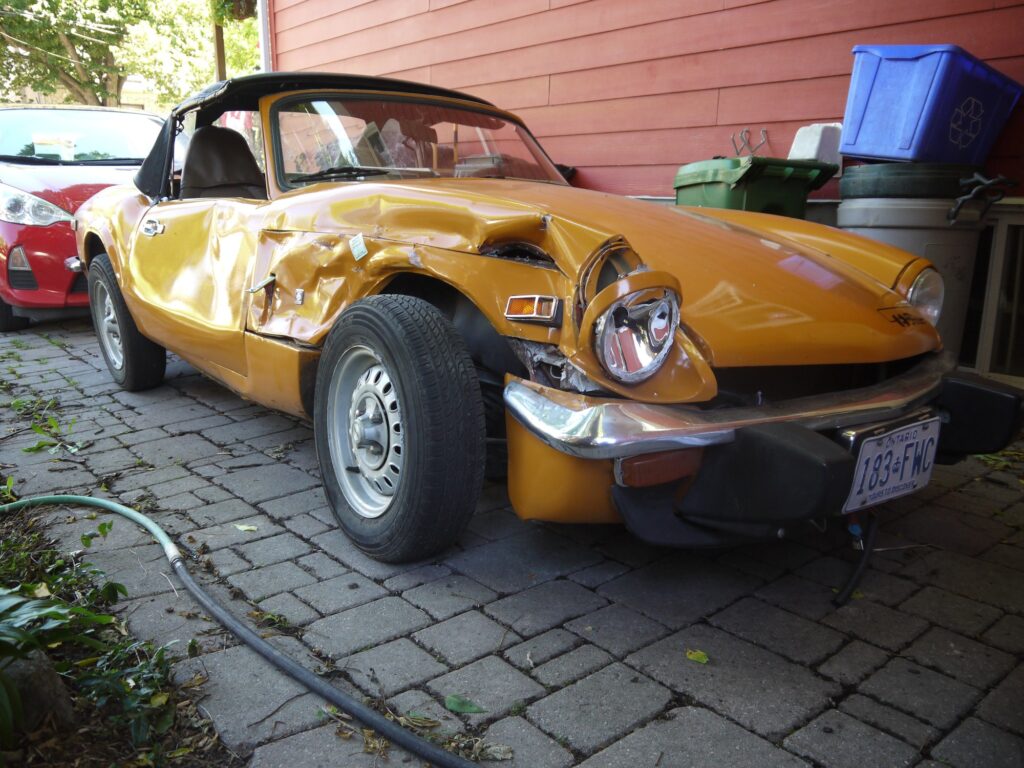
You’ll notice though that despite extensive damage to BOTH sides of the car, including that rather serious damage to the front end in the photo above, the car did not catch fire, there were no electric shocks, and no other problems. The electric components came through the crash in good condition, and as part of the compensation package, I received the vehicle for salvage.
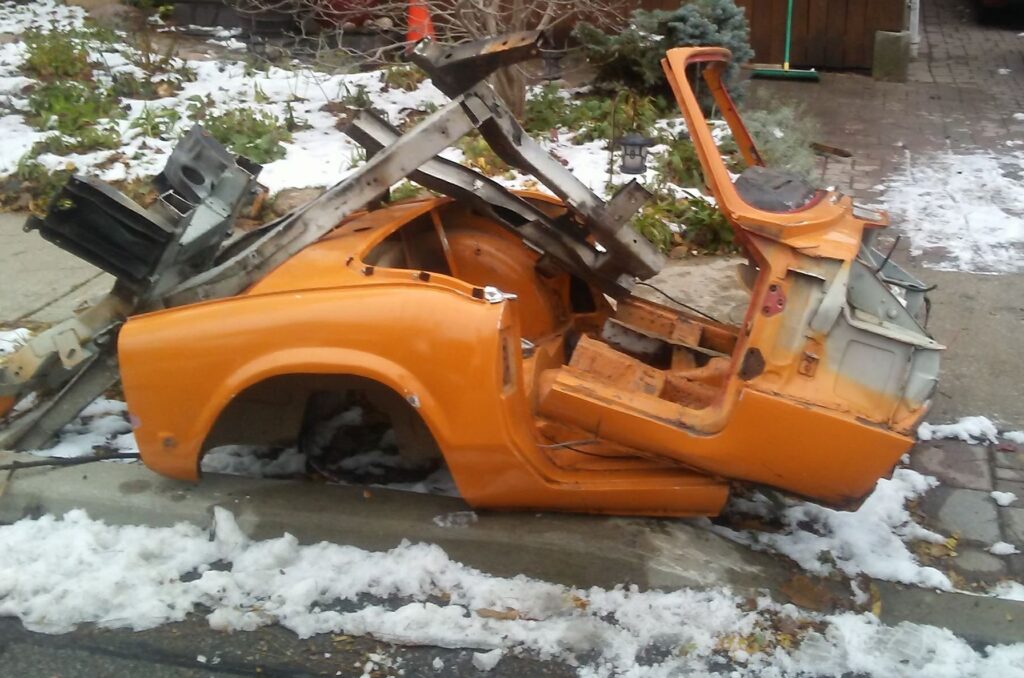
(chopping the car up into bite-sized pieces for the “urban raccoons” (salvagers who drive around town looking for scrap metal on garbage day) was one of the saddest days I’ve experienced)
The thought immediately turned to E-Fire Mark II- but Ontario’s insurance program put that idea entirely on the back burner.
Fortunately, just recently, I was able to find a willing insurer- one who I’d contacted previously and been denied by. A complaint to the Financial Services Commission of Ontario, the regulator of insurance companies in the province, led to a special connection with an insurer who will write a policy- with rather restrictive terms, but for a price which for a 3rd car in a 2 driver household, is roughly what I’m paying for my other two cars. That’s better than the Facility Association quote I had, which was four times that amount and which rendered the project impractical- but it’s still four times what I’d pay for an unconverted classic car of this vintage. Insurance for converted cars is still an issue requiring advocacy and change here.
With insurance under consideration, the likely victim for conversion is a 1973 TR6 that fell into my lap recently. It has a lovely, powerful 2.5L straight 6 cylinder engine with a deafening dual exhaust- but a bum transmission that may not be worth fixing. I’m not 100% decided at present, but I do very much miss electric classic motoring- and the TR6 is quite a looker compared to the E-Fire’s amateur restoration. It may be what I get up to this winter, but that’s not 100% certain at this point.
UPDATE: I finally broke down (after the TR6 broke down…) and converted the TR6. The ER6 was my COVID project, and has been motoring with the resurrected spirit of the E-Fire. See my article about that build!
